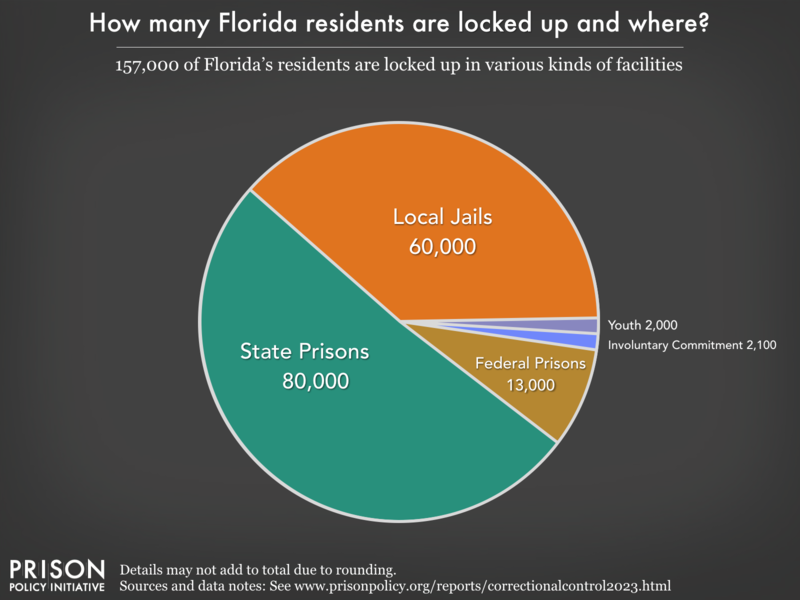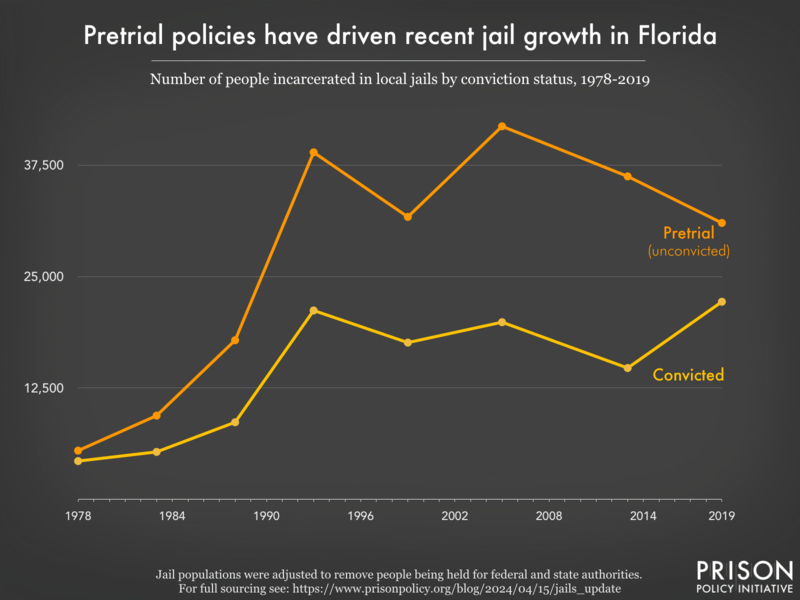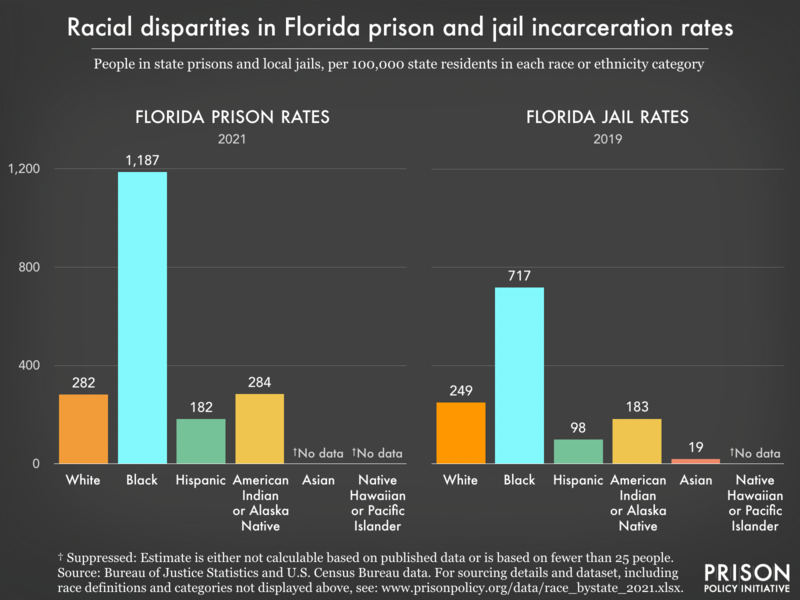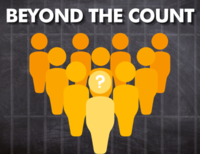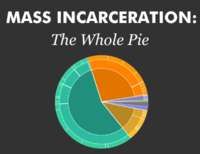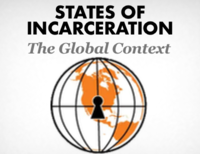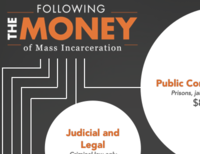Thank you,
—Peter Wagner, Executive Director
Donate
Florida profile
Florida has an incarceration rate of 795 per 100,000 people (including prisons, jails, immigration detention, and juvenile justice facilities), meaning that it locks up a higher percentage of its people than any independent democratic country on earth. Read on to learn more about who is incarcerated in Florida and why.
157,000 people from Florida are behind bars
Additionally, the number of people impacted by county and city jails in Florida is much larger than the graph above would suggest, because people cycle through local jails relatively quickly. Each year, at least 350,000 different people are booked into local jails in Florida.
Rates of imprisonment have grown dramatically in the last 40 years
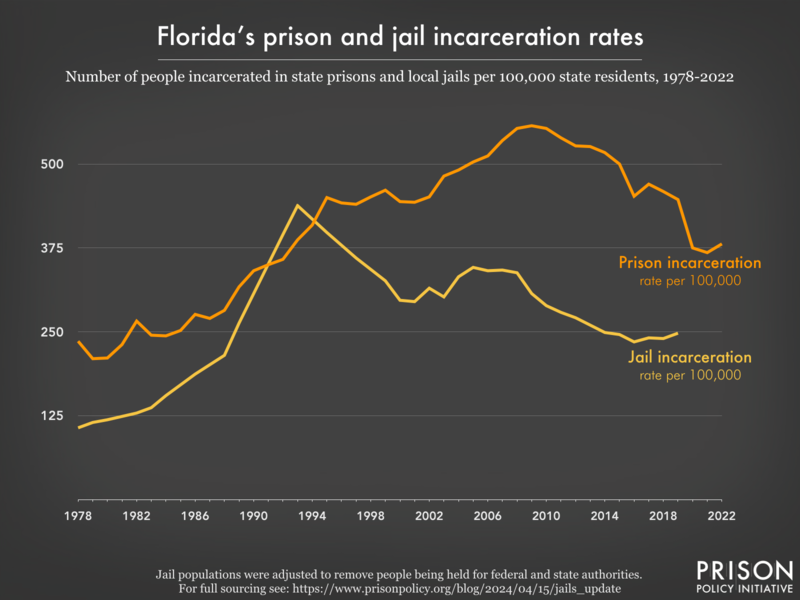
- total numbers rather than rates.
- Women’s prisons: Incarceration Rates | Total Population
- Men’s prisons: Incarceration Rates | Total Population
Today, Florida’s incarceration rates stand out internationally

People of color are overrepresented in prisons and jails
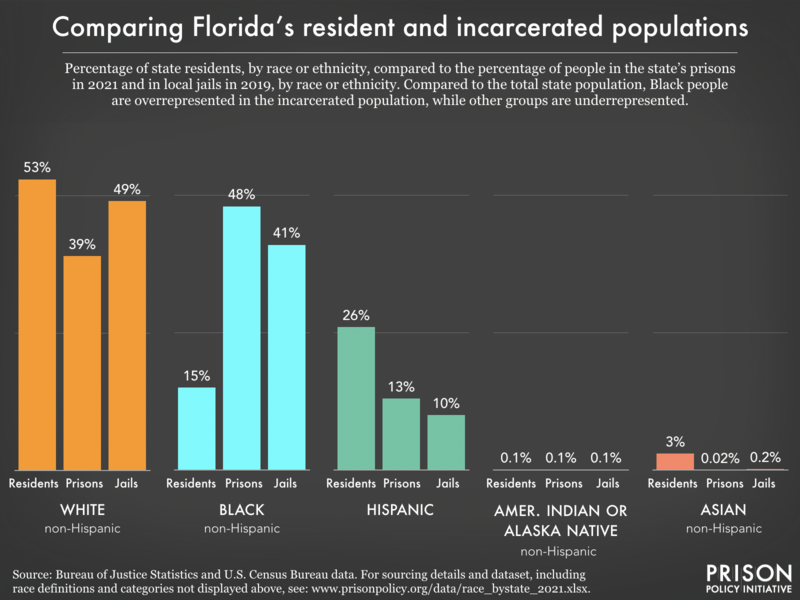
Florida's criminal justice system is more than just its prisons and jails
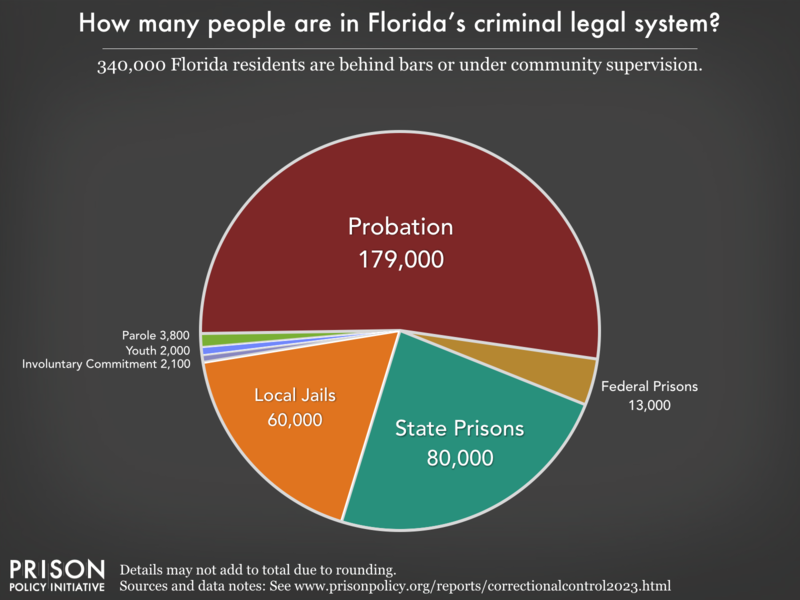
Reports and briefings about Florida's criminal legal system:
Filter to show
- People on probation in Florida are saddled with onerous rules and conditions they must follow every day or risk incarceration.
- Prisons in Florida have tablets, but they may be being used to restrict incarcerated people’s access to books and sap them of the little money they have.
- With an incarceration rate of 795 per 100,000 residents, Florida locks up a higher percentage of its people than any independent democratic country on earth.
- After the Dobbs’ decision, striking down Roe v. Wade, Florida severely restricted abortion, putting access to the service effectively out of reach for the 43,008 women on probation or parole in the state who also face travel restrictions.
- Prisons in Florida force incarcerated people and their families — some of the most vulnerable members of society — to subsidize mass incarceration.
- 58% of people in Florida jails have not been convicted of a crime, meaning they're legally innocent. There are simple steps the state can take to reduce this number. Why isn't it?
- Florida releases roughly 526,765 men and 160,337 women from its prisons and jails each year. What is it doing to support them upon reentry?
- Black people in Florida are incarcerated at a rate 4.2 times higher than white people.
- Florida's choice to criminalize "failure to appear" may be hurting public safety
- The cost of incarcerating older people is incredibly high, and their risk of reincarceration is incredibly low, yet 17% of people in Florida prisons are over the age of 55. Why is the state keeping so many older people locked up?
- Florida makes it difficult or even risky for incarcerated journalists to tell their stories.
- Florida had the highest in-prison HIV rate with 1,800 HIV-positive people in prison (almost 3% of the state’s prison population as of 2021). The state also has some of the most oppressive HIV-related criminal laws.
- Florida is one of 20 states that locks up some people convicted of sex offenses in shadowy "civil commitment" facilities, long after their sentences are over — and often indefinitely
- In Florida, 157,000 people are incarcerated and another 182,800 are on probation or parole.
- Florida charges up to 39¢ for an e-message to or from prison; well above the national average.
- Florida passed a caregiver proximity law that sets a maximum distance of 150 miles between an incarcerated parent and their child when feasible.
- Jails in Florida charge up to $5.10 for a 15-minute phone call, reaping profits for companies, while prisons charge $2.03 for a 15-minute call.
- Some Florida prisons are replacing incarcerated people's personal mail with scans, stifling family contact
- Bail companies in Florida have a track record of avoiding accountability, our report All Profit, No Risk and review of state-by-state evidence show
- Florida suspended its $5 medical copays in prisons at the beginning of the pandemic, it should eliminate them completely.
- Florida's policy on resources for the poorest people in prisons lacks important information.
- We gave Florida a failing grade in September 2021 for its response to the coronavirus in prisons.
- How many COVID-19 cases in Florida communities can be linked to outbreaks in correctional facilities? (data from our report Mass Incarceration, COVID-19, and Community Spread)
- Florida prisons charge families up to a 25% fee to transfer money to an incarcerated loved one.
- Florida hinders jury diversity by excluding people with felony records and some prior misdemeanors
- Cruel and unusual punishment: When Florida prisons don't provide air conditioning
- We graded the parole release systems of all 50 states - Florida gets an F-
- Florida incarcerates women at a rate of 159 per 100,000 residents — higher than any democratic country on earth.
- People in Florida prisons earn as little as 20¢ an hour for their work.
- Florida is 1 of only 8 states still suspending driver's licenses for drug offenses unrelated to driving
- Federal Judge holds prison gerrymandering unconstitutional
- ACLU files lawsuit challenging "prison gerrymandering" election districts in Florida county
- Reading, Writing, and Redistricting in School Board Districts with Prisons Part II: Florida
Other resources
- Research on Florida in our Research Library
